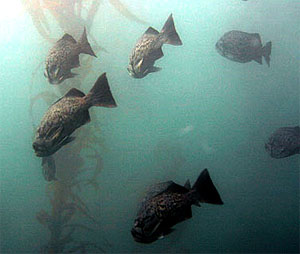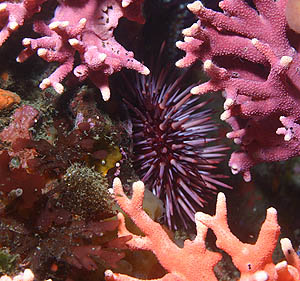
|
|||||||||||||||
|
| |||||||||||||||
The kelp canopy begins to fill in By April, the kelp canopy has usually begun to fill in, especially along protected parts of the coast. The kelp grows rapidly as sunlight increases and upwelling events bathe the kelp in cold, nutrient-rich water. As winter storms wane, the kelp forests are less likely to be damaged by storm waves. The northwest wind waves of April are smaller and have a shorter period than winter storm waves. The wind waves of spring may damage to the kelp canopy, but are less likely to damage or rip out entire holdfasts. The rate at which the kelp canopy fills in varies greatly from year to year and from place to place. In sheltered areas the canopy already may be thick in April; in exposed areas there may be no canopy at all. The extent of the kelp canopy depends on a number of factors, but the two most important are how severe the storms were during the previous winter and how protected a particular kelp bed is from the winter swells. In exposed coastal areas, large portions of the canopy are typically destroyed each winter. By April, new kelp stipes that started growing up toward the surface (from surviving holdfasts) in February or March are just beginning to reach the surface. As the kelp canopy expands, it begins to shade out the smaller red algae that, like the new kelp shoots, have been growing up from the seafloor since early spring. These "understory algae" grow at their fastest in April. By the end of the month their growth will already by slowing down as the kelp canopy fills in above them. Bull kelp reaches the sea surface As described in March, bull kelp is an annual alga that grows in exposed coastal areas and sprouts from spores on the seafloor each spring. After sprouting in January or February, these algae grow rapidly and begin reaching the surface in April. Note: A few bull-kelp plants may live for up to 18 months, so in April, in addition to new plants, you may also may see the grapefruit-sized floats of these mature algae at the surface. These year-old plants will probably survive until fall, when they get a second chance to release spores before dying off entirely. Animals begin to return to the kelp canopy  A school of blue rockfish swim around a kelp stipe. (Source: Chad King, NOAA/SIMON) For turban snails, crabs, small fishes, and other animals that live in the kelp, the expanding canopy provides increasing protection against seabirds and other predators. As new kelp stipes grow upward, they are gradually recolonized by these small animals. Not coincidentally, predators such as sea otters and rockfish also return to the kelp beds as the canopy expands. Following each spring upwelling event, a pulse of nutrients reaches the kelp beds. During the "relaxation periods" that follow upwelling events, surface currents deliver a rich soup of microscopic algae and animals toward shore. These phytoplankton and zooplankton provide a feast for small animals such as barnacles and hydroids that live in the kelp beds. Note: The phytoplankton and zooplankton that are carried toward shore during relaxation events also provide food for animals in the tide pools. However, animals in the kelp beds have "first helpings" to this food, and sometimes eat up most of the zooplankton before they can reach shore. Another major benefactor from these waves of microscopic animals are juvenile rockfish, which eat large copepods, krill larvae (and other larvae), as well as smaller juvenile fish. Large schools of juvenile blue, olive, and black rockfish begin to appear in the kelp beds during April or May. These young fish are entering the kelp beds for the first time, after spending the previous three to four months as larvae drifting at sea. After hanging out in relative safety of the kelp canopy for a few months, some of these rockfish will settle down to the seafloor later in summer. Spring-spawning rockfish release larvae While the young of blue and olive rockfish are already beginning to enter the kelp beds in April and May, other rockfish are just giving birth, releasing their larvae to drift in the waters of the open ocean. Most of these "spring-spawning rockfish" don't form large schools and are less likely to be sought after by commercial fishermen. The roster of spring-spawning rockfish includes kelp rockfish, gopher rockfish, and black-and-yellow rockfish. Fisheries biologists sometimes call these fish the "KGB complex" because they tend to hang out together and sometimes interbreed. Gopher and black-and-yellow rockfish generally follow this yearly reproductive schedule (kelp rockfish follow about a month later) Red sea urchins spawn  A red urchin hiding among rocks and California hydrocoral (Source: Steve Lonhart / SIMoN NOAA) If you put on SCUBA gear and dive down to the seafloor in April, you might be lucky enough to witness the spawning of one of the kelp's greatest potential enemies, the red sea urchin (Mesocentrotus franciscanus). These urchins feed voraciously and preferentially on giant kelp. Although some red urchins can be found spawning throughout the spring (starting as early as February), the largest number spawn between March and May. Scientists aren't sure what triggers the spawning of red sea urchins at this time of year. Some studies have shown that they may get in the mood because of increases in food supply (lots of rapidly growing kelp) and/or changes in water temperature. Note: In Southern California, red sea urchins spawn all year round. In northern California, they spawn in May or June. Around Puget Sound, red sea urchins may not reach peak spawning until June or even July. During spawning events, each female red sea urchin releases several million microscopic eggs into the surrounding seawater, just as nearby males are releasing their sperm. The urchin eggs are more likely to be fertilized when there is a relatively dense population of urchins--at least two urchins per square yard of seafloor. Those red urchin eggs that are fertilized by a sperm develop into tiny larvae, which drift at sea for a month or two. As these larvae develop, they start to eat spring-bloom diatoms--a habit they will continue for a month or so even after they settle to the seafloor. Sea urchin larvae are weak swimmers, so they are the mercy of the nearshore currents. During the upwelling season, these currents are likely to take the urchin larvae far offshore. Thus, depending on the currents and the availability of food, red-sea-urchin larvae may return to shore in droves. Or they may all drift far from the coast and die of starvation. Aside from humans and sea otters, one of the red urchin's main predators is the giant sea star, Pisaster giganteus. Like red sea urchins, giant sea stars also spawn in spring (typically during March or April). The fertilized giant-sea-star eggs eventually develop into microscopic, swimming larvae. Like the larvae of many tide-pool animals, these sea-star larvae often feed on spring diatoms. Young sea otters begin to forage on their own In April, you can still see plenty of young sea otters floating around with their mothers in the kelp beds. By this time most young sea otters have been weaned and trained by their mothers in gathering and processing food. Sometimes these young sea otters forage by themselves, but more often they continue to hang out in loose groups with other young otters and their mothers. You can often find these groups in places where kelp canopy has survived the winter and is still relatively dense. One April morning I watched a young sea otter floating all by itself near the cliffs along West Cliff Drive. The youngster dove repeatedly, but never seemed to come up with anything. However, each time the otter surfaced, a Heerman's gull would swim up to find out what kind of prey the otter had brought up. After twenty minutes of fruitless effort, the young otter gave up and just floated on its back without moving. At that point the gull flew away to look for a more reliable source of free food. |
